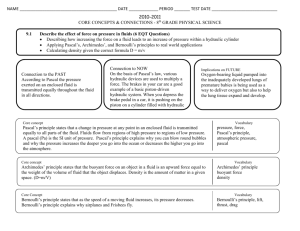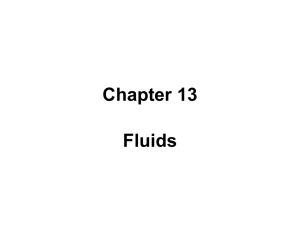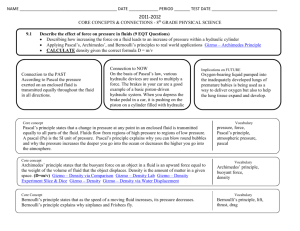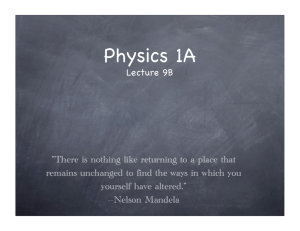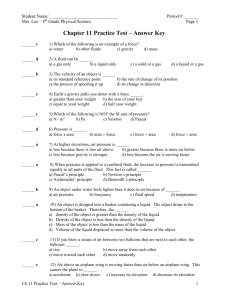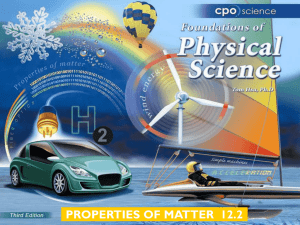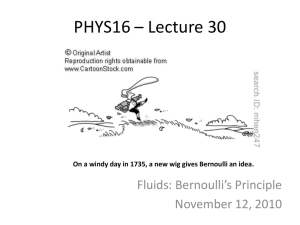Fluids
advertisement
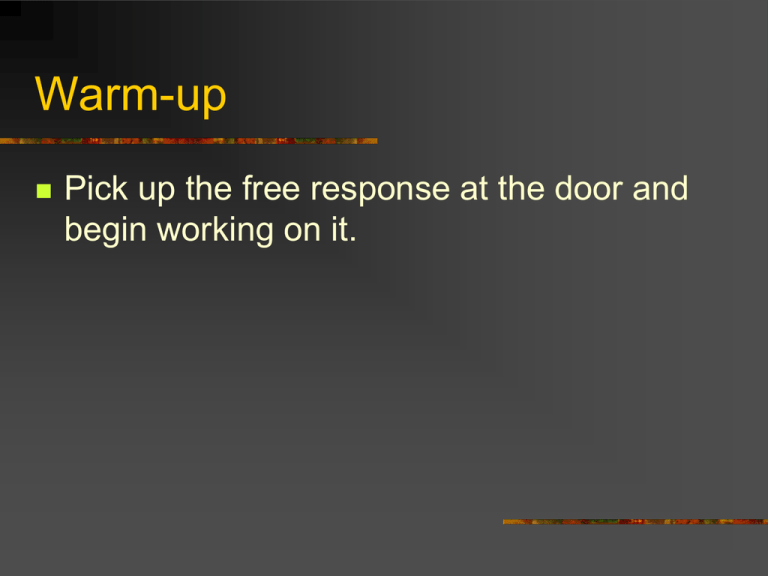
Warm-up Pick up the free response at the door and begin working on it. Do Now (10/24/13): What is Archimedes’ Principle? What is Pascal’s Principle? What is the buoyant force? Objectives Define fluids. Discuss and apply density principles. Describe pressure and its measurement in fluids. Apply Pascal’s Principle. Discuss buoyancy. Describe and apply fluid flow continuity. Discuss Bernoulli’s Equation. Today’s Plan Discuss waves test Discuss fluids FR due tomorrow. Test redo due Thursday 4/26. Homework due Thursday 4/26. Next Test Friday 4/27. Fluids Characterized by ability to flow. Gases and liquids. Liquids: assumes shape of its container but is not readily compressible Gas: expands to fill container and is compressible. Density and Specific Gravity Density: mass per unit volume () Microscopically based on molecular size and spacing between molecules. Macroscopically based on solidity of object. Specific gravity: ratio of its density to that of water at 4°C (1000 kg/m3) Pressure Pressure = Force / Area Measured in Pascals (Pa) = N/m2 Also reported in atmospheres, psi, millibars Fluids exert pressure in all directions. P= gh Practice Problem A vertical force of 30 N is applied uniformly to a flat button with a radius of 1 cm that is lying on a table. Which of the following is the best order of magnitude estimate for the pressure applied to the button? (A) 10 Pa (B) 102 Pa (C) 103 Pa (D) 104 Pa (E) 105 Pa Atmospheric Pressure Pressure due to the weight of air. At sea level, 1.013 x 105 Pa. Equates to 1.0 x 105 N per square meter of surface area. Differences in pressure are more important than absolute pressure. Practice Problem The surface of the water in a storage tank is 30m above a water faucet in the kitchen of a house. Calculate the water pressure at the faucet. Gauge Pressure Most gauges are calibrated so zero is atmospheric pressure. Add atmospheric pressure to gauge pressure for absolute pressure readings. Practice Problem If the gauge pressure of a device reads 2.026x105 N/m2, the absolute pressure it is measuring is what? Pascal’s Principle Pressure applied to an enclosed fluid is transmitted undiminished to every part of the fluid and to the walls of the container. Hydraulic lifts—small force applied to small area piston transformed to large force at large-area piston. Pascal’s Principle Pascal’s Principle P1 = P2 F1/A1 = F2/A2 Though the force applied is less than the force out, work is the same. (W=Fxd) Measuring Pressure Manometers Barometers Maximum height of a column of water Buoyancy and Archimedes Buoyancy force makes objects submerged in a fluid appear to weigh less than they do outside the fluid. Buoyant force due to increase of pressure in a fluid with depth. Upward pressure on bottom surface is greater than downward pressure on top. Buoyancy and Archimedes Buoyant force equals weight of fluid displaced by object. FB =( fluid)(Vdisplaced )g Objects float when their density is less than that of the fluid. Practice A ball that can float on water has mass 5.00 kg and volume 2.50 x 10-2 m3 . What is the magnitude of the downward force that must be applied to the ball to hold it motionless and completely submerged in freshwater of density 1.00x103 kg/m3 ? (A) 20.0 N (B) 25.0 N (C) 30.0 N (D) 200 N (E) 250 N Do Now (10/25/13): Calculate the absolute pressure at an ocean depth of 1000 m. Assume that the density of water is 1x103 kg/m3. Buoyancy and Archimedes A basketball floats in a tub of water. The ball has mass of 0.5 kg and diameter of 22 cm. What is the buoyant force? What is the volume of water displaced by the ball? What is the average density of the basketball? Moving Fluids Laminar flow: steady velocity with neighboring layers sliding by each other. Turbulent flow: speed and or direction of flow varies with erratic eddy currents present. Continuity Equation Mass flow rate in a tube of varying cross-section remains constant in an incompressible fluid. (m/ t) =( V/ t) = A l/t = Av 1A1v1 = 2A2v2 Continuity Equation Where cross-sectional area is large the velocity is small; where area is small, the velocity is large. Fluid Flow Continuity Straightstream flow Curvestream flow Practice Problem Water flows through the pipe shown above. At the larger end, the pipe has diameter D and the speed of the water is v1 . What is the speed of the water at the smaller end, where the pipe has diameter d? Making Fluids Flow Gravitational Potential Energy differences Pressure differences Bernoulli’s Equation relates pressure, velocity, and height in a fluid. Bernoulli’s Equation P1 + 1/2 v12 + gh1 = P2 + 1/2 v22 + gh2 The difference in pressure does work to change kinetic energy/potential energy of the fluid. Bernoulli’s Implications Where fluid velocity is high, pressure is low. Curveballs Airplane wings


